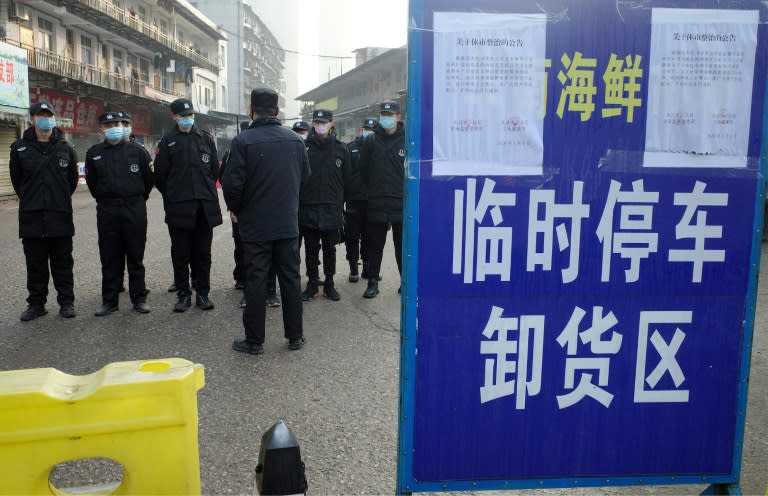Life in a Troubled Mississippi Prison, Captured on Smuggled Phones
Rick Rojas,The New York Times•January 16, 2020


An image provided by an inmate at the Mississippi
State Penitentiary, who says it shows the clothing
of a fellow inmate who was hit by nonlethal ammunition.
(The New York Times)
ATLANTA — The cellphone rang once before someone picked up. On the other end was an inmate inside Unit 29 of the Mississippi State Penitentiary in Parchman. “Hello,” he said.
Then, in a steady voice that competed against a cacophony of rowdy conversations and a fuzzy signal, he urgently described to a complete stranger the turmoil he said existed on the inside. Some inmates needed medical attention, he said. All of them could use a hot shower.
“Mold everywhere, rats everywhere,” said the inmate, who was serving time for armed robbery, aggravated assault and other charges.
Then the line suddenly fell silent. When the inmate returned a moment later, he explained that an officer had walked past and that he had needed to quickly stash his phone. He had paid $600 for the smartphone — contraband in prisons nationwide. If caught with it, years could be tacked onto his already lengthy sentence.
He then handed the phone to another inmate. “They’re treating us like animals,” that inmate said, before passing the phone on yet again.
And so it went, from one prisoner to the next, in a phone call with a reporter that stretched on for roughly an hour. The inmates complained about unreliable electricity and water, injuries that had not healed, and the vermin that forced them to hang leftover food from the ceiling. One inmate mentioned his girlfriend; another, the countdown to his release, now almost a month away.
The meandering conversation was punctuated by lulls, as the phone was hidden or passed around, capturing the ambient noise of life inside the maximum-security prison.
Parchman, the oldest prison in Mississippi, with a notorious reputation for harsh conditions, has descended into dilapidation and chaos, including a recent burst of violence that left several inmates dead.
Inmates have used illegal cellphones to capture and transmit images — inmates fighting, broken toilets, holes in prison walls, dangling wires and dead rodents caught in sticky traps — that have come to define the crisis in Mississippi. Many photos were texted to The New York Times.
Across the country, prisons are rife with smuggled cellphones, allowing inmates access to the internet, social media and their old lives outside the prison walls. But state officials said the phones have been used by inmates to propel unrest, and by gangs to orchestrate attacks on rivals, inside and outside of prison.
Officials said the pervasiveness of cellphones — nearly 12,000 were seized in Mississippi in 2018 — has threatened prison security. And, by providing an uncontrolled link to the outside world, they also have undermined the very notion of incarceration.
“There is a lot of misinformation fanning the flames of fear in the community at large, especially on social media,” Pelicia E. Hall, the state corrections commissioner, said in a recent statement. “Cellphones are contraband and have been instrumental in escalating the violence.”
Gang warfare, decrepit accommodations and a severe shortage of corrections officers has attracted widespread attention and come to dominate the state’s political agenda. Activists and others say the problems are long-standing, but they credit the images with igniting a surge of outrage.
“The story never really would have broke” without cellphones, said Honey D. Ates, whose son is serving a 15-year sentence at the state prison in Wilkinson County.
“We can hear all about it,” she said, “but actually seeing it, it’s times a hundred.”
It has been nearly impossible for corrections officials to curb the use of cellphones, as they have been difficult to ferret out. “As fast as you take them out, they’re back in,” said Martin F. Horn, a former top corrections official in New York City and Pennsylvania, who teaches at the John Jay College of Criminal Justice.
“It sort of defeats the purpose of a prison wall, if you will,” Horn said.
In recent years, an inmate on death row in Texas used a smuggled phone to make threatening phone calls to a state senator. After an hourslong riot killed seven prisoners at a state prison in South Carolina, officials there blamed phones as a reason for the violence. Even Charles Manson, the closely guarded notorious mass killer who died in 2017, was repeatedly caught with phones.
In Mississippi, inmates, their relatives and activists said that phones are often brought in by corrections officers and case managers, and the devices, usually pay-as-you-go burner phones, can cost upward of $300 inside. Elsewhere, visitors have sneaked them in, and there have been documented cases of phones being shot over prison fences with potato guns and deposited by drones.
State officials in Mississippi have resorted to a range of measures, including seeking court orders to get service providers to shut down specific devices. In a statement, the Mississippi Department of Corrections said that it also used technology to interrupt cellular signals, regularly conducted shakedowns and used dogs to sniff out the devices.
Mississippi’s prisons have been rocked by an outbreak of violence and disorder in recent weeks. Five inmates have been killed, including three at Parchman, and many others have been injured. In the chaos, two inmates escaped but were later caught. For several days, all of the prisons were locked down.
Critics said the unrest reflected a pattern of problems in state prisons, which are stretched thin under the weight of an inmate population still swollen from the tough-on-crime measures of the 1980s and 1990s. Some elected officials and civil rights groups, in a complaint calling for a federal investigation, described “extreme” staff vacancies despite having the third-highest incarceration rate in the country.
State leaders have acknowledged the severity of the concerns, and corrections officials have warned of a brewing crisis as they press lawmakers for more funding. On Monday, Hall, the corrections commissioner, issued a statement reiterating concerns over Unit 29 at Parchman, quoting a letter she had sent in August describing a facility that was “unsafe for staff and inmates due to age and general deterioration.”
As the violence flared, inmates broadcast live on Facebook as fires raged inside one prison. They posted images of faucets spewing discolored water, and walls splotched with mold.
Those images catapulted the crisis into public, coming at a pivotal moment as a new legislative session begins and Gov. Tate Reeves, a Republican, was sworn in on Tuesday.
Officials and others have said that much of the unrest has quieted. The state Department of Corrections has lifted lockdowns at all of its facilities except for Parchman. But the recent turmoil has brought new scrutiny, including from the rappers Jay-Z and Yo Gotti, who filed a lawsuit on Tuesday on behalf of prisoners, assailing what they described as an “utter disregard” for inmates and their rights.
State officials have countered that the depictions shared on social media only added to the discord. The outgoing governor, Phil Bryant, told reporters recently that the inmates craved limelight. “You’re making them stars,” he said, “and they’re convicts.”
Albert Sykes, an activist on criminal justice issues, said many inmates feared repercussions over cellphones, a lifeline for staying in touch with families, especially as rolling lockdowns caused by staffing shortages have curtailed visitation.
The inmates’ fears have been fueled by the case of Willie Nash, who was sentenced to 12 years in prison for having a cellphone in a county jail. He was being held on a misdemeanor count when he asked a jailer if he could charge his phone’s battery, an inquiry that led to the new charge. The sentence was upheld last week by the Mississippi Supreme Court, even as justices noted that it was “obviously harsh” and “seems to demonstrate a failure of our criminal justice system.”
Ates said that her son had expressed his own fear, but that she had encouraged him to be defiant. “You can’t shut all of us up,” she said, “and you can’t take all the cellphones.” In recent weeks, she has become something of a switchboard operator, receiving messages on Facebook from inmates across the state.
One video that has been widely shared showed an inmate at Parchman, who spoke on the phone briefly the other day, with an open wound that he said he had received after being struck by what he thought was a rubber bullet. His back was covered in blood and he walked over to a sink, where he turned the knobs but no water came out.
“Please try to help us,” said the inmate, who was convicted on aggravated assault and gun possession charges. “Let the world know.”
He then passed the phone back to its owner. Its battery was draining, and the electricity had flickered out again. The inmate apologized for cutting the conversation short, but said he needed to go.
This article originally appeared in The New York Times.
© 2020 The New York Times Company
ATLANTA — The cellphone rang once before someone picked up. On the other end was an inmate inside Unit 29 of the Mississippi State Penitentiary in Parchman. “Hello,” he said.
Then, in a steady voice that competed against a cacophony of rowdy conversations and a fuzzy signal, he urgently described to a complete stranger the turmoil he said existed on the inside. Some inmates needed medical attention, he said. All of them could use a hot shower.
“Mold everywhere, rats everywhere,” said the inmate, who was serving time for armed robbery, aggravated assault and other charges.
Then the line suddenly fell silent. When the inmate returned a moment later, he explained that an officer had walked past and that he had needed to quickly stash his phone. He had paid $600 for the smartphone — contraband in prisons nationwide. If caught with it, years could be tacked onto his already lengthy sentence.
He then handed the phone to another inmate. “They’re treating us like animals,” that inmate said, before passing the phone on yet again.
And so it went, from one prisoner to the next, in a phone call with a reporter that stretched on for roughly an hour. The inmates complained about unreliable electricity and water, injuries that had not healed, and the vermin that forced them to hang leftover food from the ceiling. One inmate mentioned his girlfriend; another, the countdown to his release, now almost a month away.
The meandering conversation was punctuated by lulls, as the phone was hidden or passed around, capturing the ambient noise of life inside the maximum-security prison.
Parchman, the oldest prison in Mississippi, with a notorious reputation for harsh conditions, has descended into dilapidation and chaos, including a recent burst of violence that left several inmates dead.
Inmates have used illegal cellphones to capture and transmit images — inmates fighting, broken toilets, holes in prison walls, dangling wires and dead rodents caught in sticky traps — that have come to define the crisis in Mississippi. Many photos were texted to The New York Times.
Across the country, prisons are rife with smuggled cellphones, allowing inmates access to the internet, social media and their old lives outside the prison walls. But state officials said the phones have been used by inmates to propel unrest, and by gangs to orchestrate attacks on rivals, inside and outside of prison.
Officials said the pervasiveness of cellphones — nearly 12,000 were seized in Mississippi in 2018 — has threatened prison security. And, by providing an uncontrolled link to the outside world, they also have undermined the very notion of incarceration.
“There is a lot of misinformation fanning the flames of fear in the community at large, especially on social media,” Pelicia E. Hall, the state corrections commissioner, said in a recent statement. “Cellphones are contraband and have been instrumental in escalating the violence.”
Gang warfare, decrepit accommodations and a severe shortage of corrections officers has attracted widespread attention and come to dominate the state’s political agenda. Activists and others say the problems are long-standing, but they credit the images with igniting a surge of outrage.
“The story never really would have broke” without cellphones, said Honey D. Ates, whose son is serving a 15-year sentence at the state prison in Wilkinson County.
“We can hear all about it,” she said, “but actually seeing it, it’s times a hundred.”
It has been nearly impossible for corrections officials to curb the use of cellphones, as they have been difficult to ferret out. “As fast as you take them out, they’re back in,” said Martin F. Horn, a former top corrections official in New York City and Pennsylvania, who teaches at the John Jay College of Criminal Justice.
“It sort of defeats the purpose of a prison wall, if you will,” Horn said.
In recent years, an inmate on death row in Texas used a smuggled phone to make threatening phone calls to a state senator. After an hourslong riot killed seven prisoners at a state prison in South Carolina, officials there blamed phones as a reason for the violence. Even Charles Manson, the closely guarded notorious mass killer who died in 2017, was repeatedly caught with phones.
In Mississippi, inmates, their relatives and activists said that phones are often brought in by corrections officers and case managers, and the devices, usually pay-as-you-go burner phones, can cost upward of $300 inside. Elsewhere, visitors have sneaked them in, and there have been documented cases of phones being shot over prison fences with potato guns and deposited by drones.
State officials in Mississippi have resorted to a range of measures, including seeking court orders to get service providers to shut down specific devices. In a statement, the Mississippi Department of Corrections said that it also used technology to interrupt cellular signals, regularly conducted shakedowns and used dogs to sniff out the devices.
Mississippi’s prisons have been rocked by an outbreak of violence and disorder in recent weeks. Five inmates have been killed, including three at Parchman, and many others have been injured. In the chaos, two inmates escaped but were later caught. For several days, all of the prisons were locked down.
Critics said the unrest reflected a pattern of problems in state prisons, which are stretched thin under the weight of an inmate population still swollen from the tough-on-crime measures of the 1980s and 1990s. Some elected officials and civil rights groups, in a complaint calling for a federal investigation, described “extreme” staff vacancies despite having the third-highest incarceration rate in the country.
State leaders have acknowledged the severity of the concerns, and corrections officials have warned of a brewing crisis as they press lawmakers for more funding. On Monday, Hall, the corrections commissioner, issued a statement reiterating concerns over Unit 29 at Parchman, quoting a letter she had sent in August describing a facility that was “unsafe for staff and inmates due to age and general deterioration.”
As the violence flared, inmates broadcast live on Facebook as fires raged inside one prison. They posted images of faucets spewing discolored water, and walls splotched with mold.
Those images catapulted the crisis into public, coming at a pivotal moment as a new legislative session begins and Gov. Tate Reeves, a Republican, was sworn in on Tuesday.
Officials and others have said that much of the unrest has quieted. The state Department of Corrections has lifted lockdowns at all of its facilities except for Parchman. But the recent turmoil has brought new scrutiny, including from the rappers Jay-Z and Yo Gotti, who filed a lawsuit on Tuesday on behalf of prisoners, assailing what they described as an “utter disregard” for inmates and their rights.
State officials have countered that the depictions shared on social media only added to the discord. The outgoing governor, Phil Bryant, told reporters recently that the inmates craved limelight. “You’re making them stars,” he said, “and they’re convicts.”
Albert Sykes, an activist on criminal justice issues, said many inmates feared repercussions over cellphones, a lifeline for staying in touch with families, especially as rolling lockdowns caused by staffing shortages have curtailed visitation.
The inmates’ fears have been fueled by the case of Willie Nash, who was sentenced to 12 years in prison for having a cellphone in a county jail. He was being held on a misdemeanor count when he asked a jailer if he could charge his phone’s battery, an inquiry that led to the new charge. The sentence was upheld last week by the Mississippi Supreme Court, even as justices noted that it was “obviously harsh” and “seems to demonstrate a failure of our criminal justice system.”
Ates said that her son had expressed his own fear, but that she had encouraged him to be defiant. “You can’t shut all of us up,” she said, “and you can’t take all the cellphones.” In recent weeks, she has become something of a switchboard operator, receiving messages on Facebook from inmates across the state.
One video that has been widely shared showed an inmate at Parchman, who spoke on the phone briefly the other day, with an open wound that he said he had received after being struck by what he thought was a rubber bullet. His back was covered in blood and he walked over to a sink, where he turned the knobs but no water came out.
“Please try to help us,” said the inmate, who was convicted on aggravated assault and gun possession charges. “Let the world know.”
He then passed the phone back to its owner. Its battery was draining, and the electricity had flickered out again. The inmate apologized for cutting the conversation short, but said he needed to go.
This article originally appeared in The New York Times.
© 2020 The New York Times Company
---30---












